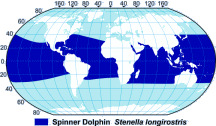Gray's Spinner Dolphin
CLASS: Mammalia
ORDER: Cetacea
SUBORDER: Odontoceti
FAMILY: Delphinidae
GENUS: Stenella
SPECIES: longirostris
The first published reference to the spinner dolphin appeared in 1769. The Benedictine monk Dom Antoine-Joseph Pernety sighted a school of several hundred unusual dolphins off West Africa while on a voyage to the Falkland Islands in the South Atlantic. The dolphins "sprang out of the water in an extraordinary manner." They "leaped at least three or four feet high and turned round not less than three times in the air, as if they had been on a spit." Only the spinner dolphin has been seen to spin several times in the air like this in the wild (W. F. Perrin and James Gilpatrick, Jr.). SHORT-SNOUTED SPINNER Little is known about the short-snouted Atlantic spinner. It ranges from the Gulf of Mexico to the Caribbean, and from the mid-Atlantic to the northwest coast of Africa. Its length is 7 feet (2 m), and its weight is 200 pounds (90 kg). Its flippers are small and pointed at the tips, and its dorsal fin is curved and nearly pointed, and is located in the middle of the back. Its color is dark gray on the upper body, with a light gray area from the eyes along the sides to the tail; its belly is white. It eats small fish and squid, and is found in small herds in very deep water. LONG-SNOUTED SPINNER The known Pacific forms of this species include the Costa Rican, the eastern, the whitebelly, the Hawai'ian (Gray's), and a dwarf form found in the Gulf of Thailand. They are differentiated by size -- ranging from 5.5 to 6 feet (1.65 to 1.8 m) for the eastern spinner, to 7 feet (2m) for the Costa Rican spinner; by weight -- from 135 pounds (61 kg) for the eastern, to 200 pounds (91 kg) for the Hawai'ian; and by differences in shape and markings. The Hawai'ian form seems to be typical for the species elsewhere in the range including the Indian and Atlantic oceans.
Physical Description
The body size, shape, and color patterns of the various forms differ according to geographical location. Spinners in general all share common characteristics: their bodies are slender, their beaks are long and thin (except for the Atlantic short-snouted spinner) and their flippers are small and pointed at the tips. Their coloring is in shades of dark gray, light gray, and white; most forms have white bellies.

Surface Characteristics
Feeding
The spinner dolphin's diet consists of small fish and squid. Spinners have more teeth than other species of dolphins, with between 45 to 65 sharp, pointed teeth in each side of both the upper and lower jaws. They feed at night.
Mating and Breeding
Females reach sexual maturity at about 4 to 7 years, males at about 7 to 10 years. A newborn calf averages 32 inches (80 cm) in length. The gestation period is 10 1/2 months, and the calving interval is between 2 to 3 years. Calves nurse for from 1 to 2 years.

Range Map
Distribution and Migration
The Costa Rican spinner is found in large, close-knit groups of 1,000 or more animals in coastal waters less than 90 miles (150 km) off the western coast of Central America; the eastern spinner is a more oceanic species found in deep water off the coast of Mexico and the west coast of Central America, often travelling in large herds of thousands or more, sometimes in the company of spotted dolphins; the whitebelly spinner is distributed even further offshore from Mexico, Central America, and the Pacific region of northern South America, travelling in herds of 1,000 or more; the Hawai'ian spinner is common throughout the Hawai'ian Islands and congregates in herds of 200 or more.
Natural History
Spinner dolphins frequently travel in the company of other species, such as the spotted dolphin and, in Hawai'i, humpback whales. In the eastern tropical Pacific, spinner dolphins swim with yellowfin tuna, an association that has led to the slaughter of hundreds of thousands of spinners in the purse-seine tuna fishery. Known predators are sharks, killer whales, and possibly false killer whales, pygmy killer whales, and pilot whales.
Status
Whitebelly and eastern spinner dolphins in the eastern tropical Pacific have suffered enormous population losses as a result of entanglement in the nets of tuna fishermen. For a reason not yet known, they swim in herds above schools of yellowfin tuna. Instead of looking for tuna, the fishermen look for dolphins; when they find them, they encircle the herd with large nets called "purse seine" nets, capturing the dolphins along with the tuna. It is believed that the stock has declined by as much as 80% since the 1960s, when purse seining operations began. Spinner dolphins do well in captivity, and have been displayed in Hawai'i and elsewhere in the U.S., Indonesia, the Philippines, and Hong Kong.
Bibliography
- Jefferson, T.A., M.A. Webber, R.L. Pitman. 2015 Marine Mammals of the World: A Comprehensive Guide to Their Identification, 2nd Edition. Elsevier/AP.
- Norris, K.S., B. Würsig, R.S. Wells, and M. Würsig. 1994. The Hawaiian Spinner Dolphin, University of California Press. Berkeley, CA. 408 pp.
- Perrin, William F., and James W. Gilpatrick, Jr. 'Spinner Dolphin' Stenella longirostris.
- Perrin, W.F. 2002. Spinner Dolphin. In Encyclopedia of Marine Mammals, ed. By W.F.
- Perrin, B. Würsig, and J.G.M. Thewissen, Academic Press, San Diego, CA. Pp. 1174-1178. Perrin, W.F. and J.W. Gilpatrick, Jr. 1994. Spinner dolphin, Stenella longirostris (Gray 1828). In Handbook of Marine Mammals, Vol. 5, ed. By S.H. Ridgway and R. Harrison, Academic Press, London, pp. 99-128.
Acknowledgements
- Illustrations courtesy Uko Gorter, copyright ©2017 all rights reserved.
FACT SHEETS MAY BE REPRINTED FOR EDUCATIONAL OR SCIENTIFIC PURPOSES
|



